|
|

| Now showing:
|
Past issues
|

|
|
#10
The marabou
|
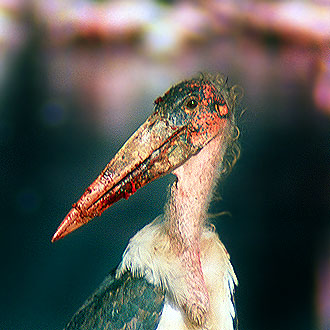
Marabou stork, 'Leptoptilos crumeniferus'. J.Y./Kenyalogy.com
|
"Oh my, that poor bird... What on Earth happened to its face?", says an old lady. The answer, madame, is just one word: evolution. If this bird looks like Vincent Price in 'House of Wax', it has nothing to do with fireworks mismanipulation. Vultures and other scavenger birds lack feathers on the head and neck since it would be uncomfortable to keep them clean and in place when they have to dip them in the hot and rotting haggis of some other guy. But why, besides this, evolution was so heartless to give the marabou such a freakingly weird face, who knows.
A different question is why this particular guy on the image has its beak stained with blood and some other quite repulsive stuff. The picture was taken at Lake Nakuru, and this marabou was eating a flamingo. Alive.
Oh, by the way, actually the marabou is not a vulture, but rather a stork. Needless to say, the day one of these birds delivers a baby, we will know that the Antichrist is coming.
|
|
#9
The dugong
|
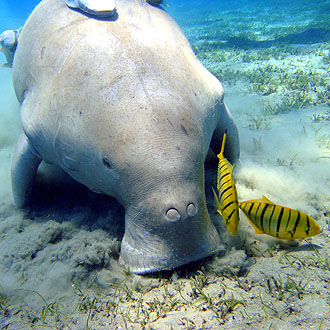
Dugong, 'Dugong dugon'. Julien Willem/Wikipedia
|
So much sea floor to vacuum and so few dugongs... Actually few and even less, since dugongs are seriously threatened, mainly by us, as usual. They are classified as vulnerable by the IUCN red list, but they are critically endangered locally in regions like the East African coast, although their native habitats comprise the full Indian Ocean and part of the Pacific.
But the dugong is not on this list only because of its likeness to the perfect ocean's vacuum cleaner. It is also the only strictly marine herbivore mammal in the world, since its cousins, the manatees, can also live in fresh water. The dugong is a sea cow, with its strange mouthpipe adapted to grazing and uprooting submarine grass.
Like its cousins the manatees, the dugongs are sirenians. They were so called by scientists who said Greek sailors mistook these animals for mermaids. In other words: some scientist wants you to believe that Greek sailors looked at a dugong and saw Daryl Hannah. That's a freakingly weird idea.
|
|
#8
The hyena
|
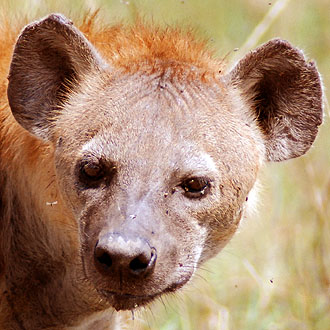
Spotted hyena, 'Crocuta crocuta'. J.Y./Kenyalogy.com
|
Well. It's a hyena. So what? All right, you already know that the hyena is a weird creature. Ugly as it can be, with the ability to digest a full antelope, bones and hide and skull and teeth and hooves and all except for rumen contents (even a hyena has its dignity), and with that blood-chilling Norman Bates-like hysterical laughter.
But what really makes a hyena a freakingly weird creature is something you never heard at school. Why? Well... Possibly because few teachers ever dare to talk about the female hyena's genitalia. Mama spotted hyena's clitoris is erectile and so huge that it resembles the male's penis, and its labia are fused in a pseudo-scrotum. There is no vaginal opening. And how...? Well, the female's thing is thicker than the male's, and it has a longitudinal canal. Got it?
Because of this, hyenas were thought at first to be hermaphrodites. Possibly the alternative was unthinkable at that time, although today we know that homosexuality is not unheard of in animals.
|
|
#7
The siafu
|
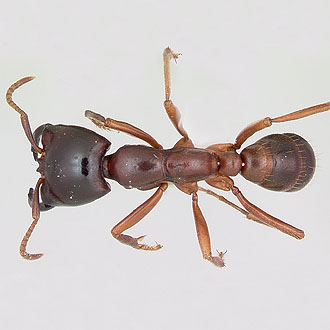
Siafu ant, 'Dorylus gribodoi'. April Nobile & antweb.org/Wikipedia
|
So, here is the guy that almost ate up Charlton Heston. Well, not exactly, since 'The naked jungle' movie was set in South America and siafu ants are native from Africa, though they are also found in Asia. However it seems that the nickname has stuck.
These ferocius gals --workers and soldiers are sterile females-- are famous for their columns amounting 50 million that consume everything in their path. Conversely to what Hollywood shows us, usually they are not dangerous to people, but if your home happens to be right in the column's way, better get out. In colonial times, some jolly settlers would leave a caged parrot, and then they had a good laugh watching the bird's skeleton still standing on its perch. Once I had the chance to see a swarm eating up a toad, and the violent writhing suggested that the poor victim was not having a great time.
Still, they are beneficial since they eliminate pests, and their jaws, freaking weirdly enough, are used in the bush as emergency surgical staples.
|
|
#6
The spiny orb-weaver
|
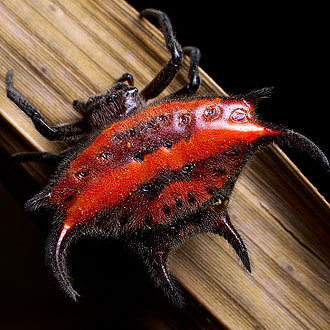
Spiny orb-weaver, 'Gasteracantha falcicornis'. Nick Hobgood/WIki
|
Either you love spiders or you hate them. When it comes to spiders, there is no N/A category. But take a look at this beauty. Even if you hate spiders, you might at least like crab chowder.
The spiny orb-weaver is freakingly weird for a spider. Still, it is a member of a genus that has hundreds of species and subspecies throughout the world, and it is a near cousin of the common garden spiders. In Kenya, it is a creature you will very likely stumble upon if you go camping in the bush, since it can be easily found weaving its web between branches of trees or shrubs. So if you leave the camp heading for nature's bathroom, you will possibly get back to your tent with one or two of these guys sticking to your clothes without a warning from your Spidey sense.
But no worries: despite its frightful Satan-ish appearance and those unfriendly spikes, the spiny orb-weaver is not a dangerous creature. That means it won't take you to hospital. But of course it bites, since that is what spiders are supposed to do.
|
|
#5
The giant African millipede
|

Giant African millipede, 'Archispirostreptus gigas'. wallygrom/Flickr
|
Now, what about a 15-inch (38 cm) bug for a freakingly weird pet? No jokes: people breed giant African millipedes and keep them as animal companions. For some reason, millipedes are more pleasant to us humans than centipedes. It might well be a hard-learned evolutionary lesson, since centipedes are carnivorous, venomous and have painful bites, while millipedes are herbivorous and (mostly) harmless. Add that a millipede will share your home for 5 to 7 years and that your grandma won't have to knit booties for its couple hundred feet.
That said, truth is that this guy is not fully innocuous. When disturbed, its body glands will secrete an irritant liquid. But millipedes are nice and beneficial, since they feed on decaying vegetable matter and will consume your spoiled lettuce, so your little friend will also make a perfect waste disposal unit.
In the wild, they inhabit forests and are not rare, though they are only found below 3,300 ft (1,000 m), out of range for the average Kenya safari.
|
|
#4
The large-eared free-tailed bat
|
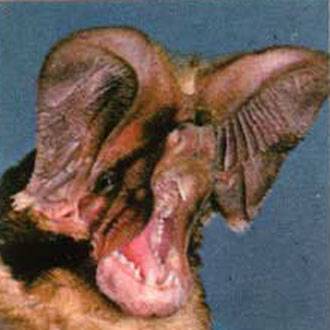
Large-eared free-tailed bat, 'Otomops martiensseni'.
|
Ok, I admit that tucking a bat into a list of freakingly weird creatures is always an easy way out, since bats are usually ugly. But this one could surely win the world prize for the ugliest bat in the world. Or the ugliest animal. Even the ugliest whatever ever. Evolution must have been sadistic to give this guy such a freakingly weird face that seems a Munch's screaming butterfly gone werewolf. The picture shown here is not great. There's a much better one here, which I couldn't use, that shows this guy in its full glory.
The large-eared free-tailed bat is rare in Kenya, though it is actually distributed through most of Sub-Saharan Africa. In Kenya it lives predominantly in deep and remote lava caves of Mount Suswa, in the Kedong section of the Rift Valley.
But surely this poor Quasimodo bat is screaming for help, since its kin is seriously threatened. Some help may come along: in February 2013, Naivasha will host the first African bat conservation summit.
|
|
#3
The aardvark
|

Aardvark, 'Orycteropus afer'. dipthongasaurus rex/Flickr
|
Remember the time when naughty children at school were forced to wear donkey ears and a pig snout? Well, it seems nobody remembered to lift poor aardvark's punishment.
But actually the animal best known for being the first entry in the English dictionary is not related to pigs, donkeys, or even the anteater which it is frequently mistaken for. It is the only species in the only genus in the only family in its own order ('Tubulidentata'), which is as much as saying that it hasn't had anyone with whom to share the hardships of life for the last 2.5 million years. Its closest relatives are elephant shrews and golden moles, along with hyraxes, dugongs and elephants. A freakingly weird kin.
Who knows if because of this solitary fate, the aardvark is shy, burrower and strictly nocturnal, hence it only shows up in night game drives. Its diet consists of ants and termites which it catches with its long and sticky tongue, being one of the few animals that dare to brave the fearsome siafu.
|
|
#2
The giant rat
|
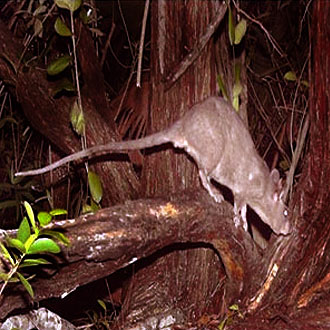
African giant pouched rat, 'Cricetomys gambianus'. USDA
|
One night, at Tusk Camp in Aberdare National Park, I went out for a walk when I suddenly glimpsed a furry creature creeping in the dark. I was astonished not by what it looked like, but by its size. It was huge. Larger than a cat. At once I raced to grab my Collins field guide and I browsed through the plates searching for what I had just seen and expecting to find some "Hoffman's forest groundhog" or "Birkett's fat mongoose". But what I found was plain and exactly what I had seen: "Giant rat".
It's not that rats are intrinsically disgusting. But a rule of thumb for wildlife watching is "if you see one, there are more". More? If a movie would come to mind in such a situation, it'd be 'The food of the Gods'.
Actually there is nothing to fear about these freakingly weird rodents. They are so nice that many people have them as pets. It was precisely a careless breeder who made this rat an invasive species in the Florida keys. They are also used for mine detection (I know, but blame it on who put the mines first).
|
|
#1
The naked mole rat
|
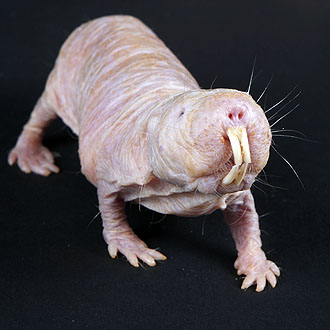
Naked mole rat, 'Heterocephalus glaber'. Smithsonian's/Flickr
|
Poor little naked mole rat. Everyone's reaction when they first see the freakingly weirdest among the freakingly weird is... laughing. Some, specially men, find a resemblance to some organ (teeth apart).
There is so much weird stuff about our winner. It is the only cold-blooded mammal and one of the only eusocial mammals, living in underground hierarchical communities led by a queen, like ants or bees. Their lips are sealed just behind the digging teeth to avoid eating soil. They feed on tubers they find while burrowing, but they can survive on their own feces (which are the only food for the pups). They are almost blind, and their skin is insensitive to pain and acid. They can run backwards as fast as forward. They are extremely long-lived, reaching 30 years in contrast with the 3 years a mouse can live. Last but not least, they never get cancer. Enough?
They are quite abundant in dry areas. In Samburu, along the sandy river banks, you may spot their miniature sand volcanoes puffing dust up in the air.
|
|
Bonus:
The oxpecker
|

Red-billed oxpecker, 'Buphagus erythrorhynchus'. Profberger/Wiki
|
It couldn't be left outside this list. Or shouldn't there be a place of honor for a creature fond of a delicious menu consisting of (take note) ticks, blood, shreds of necrotic flesh, earwax and dandruff? Vomiting yet? Well, even more unbelievable is that such a freakingly weird pervert is a nicely colored, bucolic-looking bird.
Ladies and gentlemen, say hello to the oxpecker. Despite its fate to be ignored by flashes, this
extra of the bush manages to slip in almost every picture due to its habit of living on the back of large mammals, where it harvests its tasty diet.
In the times when people used to say that nonsense about nature being wise (it is not wise nor ignorant, same as a can of beans is not agile nor clumsy), it was taken for granted that oxpeckers were beneficial to mammals by helping them getting rid of ticks. Nice, but untrue. They just mind their own affair, and their presence does not reduce their host's parasite load. In fact, they keep wounds open to have their shots of blood at hand. The oxpecker is actually the likeliest candidate for a vampire bird. So next time you think about Dracula, think twice.
|
|
|



